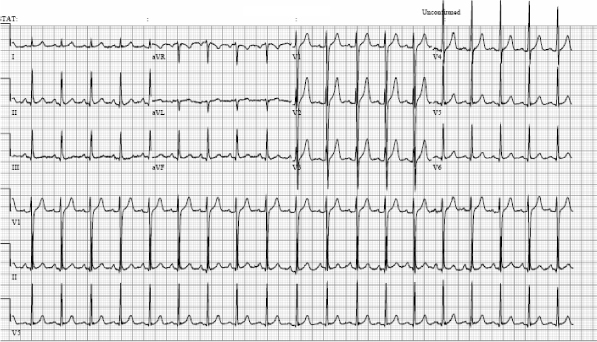
Mr. Fablicur
Mr. Fablicur, a previously healthy 26-year old, has been feeling increasingly unwell. Follow his path through the health care system to learn about his diagnosis and management.
NOTE: for answers, please scroll over underlined words
- Primary Care
- Specialist Care
- Management
- Case Objectives
Primary Care - Mr. Fablicur visits his GP
Mr Fablicur describes difficulty lying flat on his back while sleeping due to his shortness of breath. What is the term for this condition?
A: dyspnea answer (hover mouse for answer)
|
Mr Fablicur's symptoms include fatigue, progressive shortness of breath, and pedal edema. The differential is large at this point.
What physical exam finding would be most helpful in narrowing the differential diagnosis?
A: jugular venous pressure (JVP) of 7 cm
B: capillary refill of 2 seconds
C: expiratory wheeze
D:
blood pressure of 142/92
E: split S2 on inspiration
answer
What is your differential diagnosis?
answer |
What initial investigations would you perform?
answer |
Suspecting a problem with Mr. Fablicur's heart, the doctor asks the family practice nurse to do an ECG.

- Q: what does Mr. Faiblicur's ECG show? answer
Mr. Fablicur's GP orders a chest X-ray and discusses the findings.
Q: role-play an appropriate explanation of the chest X-ray.
|
What should be the next step?
answer |
return to tab top to continue with The Case of Mr Faiblicur
Specialist Care
Mr Fablicur meets with the cardiologist, who arranges cardiac catheterization to produce a left ventriculogram.
Recall Mr. Fablicur is 26 years old and presented with new onset, progressive, shortness of breath, fatigue, and pedal edema.
What does Mr. Fablicur's clinical picture and imaging suggest as a diagnosis?
A: pulmonary hypertension answer |
scroll down for next question
Mr. Fablicur's age, signs and symptoms, and ventriculogram strongly suggest a diagnosis of dilated cardiomyopathy, the most common form of congestive heart failure seen in young adults.
What is the most common cause of dilated cardiomyopathy?
A: myocardial infarction
B: infective endocarditis
C: alcohol abuse
D:
cocaine abuse
E: idiopathic
answer
Mr. Fablicur's dilated cardiomyopathy is advanced, resulting in significant symptoms. Even though the cause of his condition is uncertain, many medications will be helpful in stabilizing his condition and improving his status.
Which class of medication is known to prevent cardiovascular remodeling in response to damage?
A: angiotensin-converting enzyme (ACE) inhibitor
B: acetylsalicylic acid (ASA)
C: beta blocker
D:
diuretic
E: statin
answer
Mr Fablicur is clearly concerned about his condition and plans on speaking with his cardiologist about his prognosis. He is encouraged by his young age, though alarmed at the severity of his symptoms.
Once dilated cardiomyopathy becomes symptomatic, what is its 50% mortality rate?
A: 1 year
B: 2 years
C: 5 years
D:
10 years
E: 15 years
answer
Mr. Fablicur sits down with his cardiologist, Dr. Billinghurst to discuss his situation.
question: how do you effectively break bad news? roly play this scenario. (more information on breaking bad news)
question: how would you manage Mr. Fablicur's care?
Management
Mr. Fablicur
Mr Fablicur visits the pharmacist and dietitian for care and advice
Case Objectives
This case can be used in a tutorial or for self-directed learning.
With the completion of this case, clinical clerks will be able to:
- demonstrate complete cardiovascular and respiratory history and physical exams, as guided by checklists (source and source)
- describe red flags for cardiovascular disease
- evaluate an ECG according to standard parameters and common/serious diagnoses (source)
- evaluate a chest X-ray in an organized manner (source)
- describe the etiology, clinical presentation, and prognosis of dilated cardiomyopathy
- describe indications and mechanism of action for common medications used in congestive heart failure
